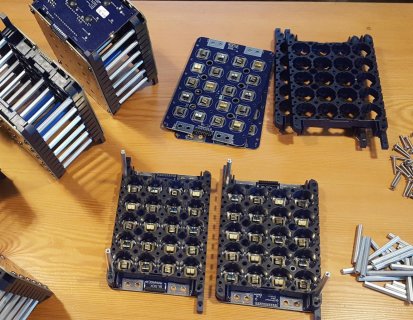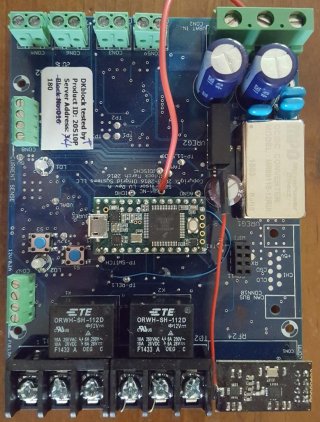Hello all,
First of all, I'd like to thank all of the forum members, and especially Paul S. for all of the amazing ideas, code and work product that is available on this forum to the greater world, and of course for the great Teensy product line. I've stood on your shoulders to produce a new Teensy LC and 3.2 based (20 - 18650 cell) battery block kit for electric vehicles that I call DKblock, that has uses gold plated phosphor bronze spring contacts for a compression cell connection, and is capable of 100A discharges. I'm using nRF24L01 for wireless communications to get rid of the common BMS problem of bad or loose small wire connections. I'd be happy to post the data sheet on the web or send to anyone interested. Below is a picture I uploaded of the basic components of the kit.
Now for my basic question. I like the idea of using the extended Kalman filter for state of charge (SOC) estimation, right now I'm only using battery and voltage information for SOC. Can the Kalman filter code used in the new Prop Shield be used as a standalone C or C++ function, and if so, are there any hints on extracting and applying that code. The Kalman inputs are voltage, current and temperature, and of course time. Filter delay is not an issue. A new estimation every few seconds would be excellent. If this seems unlikely, are there other extended Kalman filters available? I've looked at the TinyEKF code, and it seems so specific to the LM35 and the BMP180 barometer, but maybe it can be modified for V and I.
https://github.com/simondlevy/TinyEKF/blob/master/examples/SensorFusion/SensorFusion.ino
There are some nice articles on using the Kalman filter predictor for SOC designs, here is one:
https://www.mathworks.com/tagteam/76108_SAE 2013 - Simplified EKF Battery Model.pdf
I'm open to any ideas that get an accurate SOC meter using Teensy 3.2. And yes, I would be happy to share any SOC code found or written along the way!
Thanks so much!
Tim
offgrid
Here is the DKblock kit part picture:

And a picture of the 'Pack Supervisor':

First of all, I'd like to thank all of the forum members, and especially Paul S. for all of the amazing ideas, code and work product that is available on this forum to the greater world, and of course for the great Teensy product line. I've stood on your shoulders to produce a new Teensy LC and 3.2 based (20 - 18650 cell) battery block kit for electric vehicles that I call DKblock, that has uses gold plated phosphor bronze spring contacts for a compression cell connection, and is capable of 100A discharges. I'm using nRF24L01 for wireless communications to get rid of the common BMS problem of bad or loose small wire connections. I'd be happy to post the data sheet on the web or send to anyone interested. Below is a picture I uploaded of the basic components of the kit.
Now for my basic question. I like the idea of using the extended Kalman filter for state of charge (SOC) estimation, right now I'm only using battery and voltage information for SOC. Can the Kalman filter code used in the new Prop Shield be used as a standalone C or C++ function, and if so, are there any hints on extracting and applying that code. The Kalman inputs are voltage, current and temperature, and of course time. Filter delay is not an issue. A new estimation every few seconds would be excellent. If this seems unlikely, are there other extended Kalman filters available? I've looked at the TinyEKF code, and it seems so specific to the LM35 and the BMP180 barometer, but maybe it can be modified for V and I.
https://github.com/simondlevy/TinyEKF/blob/master/examples/SensorFusion/SensorFusion.ino
There are some nice articles on using the Kalman filter predictor for SOC designs, here is one:
https://www.mathworks.com/tagteam/76108_SAE 2013 - Simplified EKF Battery Model.pdf
I'm open to any ideas that get an accurate SOC meter using Teensy 3.2. And yes, I would be happy to share any SOC code found or written along the way!
Thanks so much!
Tim
offgrid
Here is the DKblock kit part picture:

And a picture of the 'Pack Supervisor':

Last edited:

